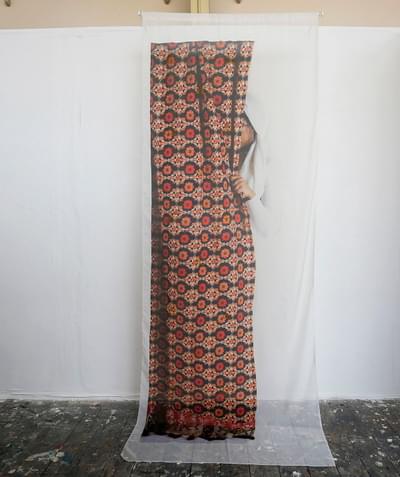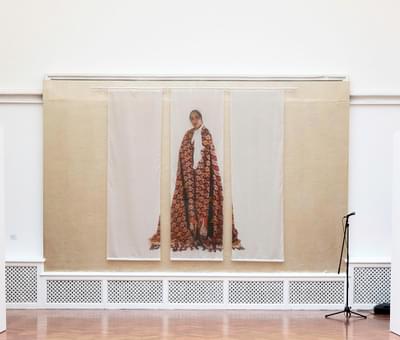News Story
In the summer of 2018, I showed two works for my BA Fine Art Degree Show: Not Your Fantasy I and Not Your Fantasy II. I was very pleased to receive an email a few months later from Birmingham Museum & Art Gallery’s Curator of Contemporary Art Emalee Beddoes-Davis asking whether I would like for Not Your Fantasy I to be shown at an upcoming exhibition entitled Women Power Protest. Marking a century since women won the right to vote, Women Power Protest was an exhibition celebrating female artists who explored protest, social commentary and identity in their work. My work explores these themes from my perspective as a Muslim woman, and I was delighted to have the opportunity to showcase my work alongside some of the most incredible female artists, both historical and contemporary. The exhibition then led to Birmingham Museum and Art Gallery (BMAG) acquiring my piece for their collection.
Not Your Fantasy is a series of textile prints concerned with re-appropriating and reclaiming Orientalist imagery of Muslim Women. The aim of the work is to unveil the voyeuristic tradition of Western male painters, whilst inviting viewers to question Orientalist stereotypes, and the prevalence of Orientalism in current society.

The images are composed of a Muslim woman clad in white, set within a white background. The lack of colour is crucial as it negates all exotic and erotic Orientalist stereotypes. The only element of colour within the piece is the fabric. It is embroidered with the words ‘Not Your Fantasy’ and patterned with fragments of Ingres’ La Grande Odalisque which has been criticised for its appropriation and sexualisation of Eastern Culture.
The fabric printed on fabric results in a pale and imprecise reproduction of the original photograph. This creates notions of figuratively pale reproductions of Muslim women within Orientalist paintings and articulates well my concern with the cultural construction and visual mediation of the ‘Orient.’ The phrase ‘Not Your Fantasy’ is challenging and clearly directed at 19th Century Orientalist painters who created scenes of harems from their imagination and were fascinated by the otherness of the Eastern woman.

The patterned fabric photographed in the work is titled Not Your Harem Girl and has been designed using elements of Jean-Auguste-Dominique Ingres’ La Grande Odalisque, a well-known Orientalist artwork from the 19th Century. The pattern includes a scanned-in image of an embroidery I created with the words ‘Not Your Harem Girl’ and also an image of a hand with a henna design I made from the same text; I often work in layers, taking time to create embroidery or henna that then feature in the work. When combined these elements form a pattern that resembles Islamic geometric art.
Islamic art is fundamentally based on the concept of Al-Tawhid (Divine Unity) (Burckhardt) and this is expressed through geometric symmetrical patterns that appear to be infinite. Designs intricately attempt to trace the origins in creation, encouraging viewers to reflect upon them not backwards but inwards (Critchlow, 1976). As such, Islamic art promotes reflection on the self and the universe and fosters an exploration of what lies beneath the visual surface.

My works are often made in response to an existing historical artwork or movement, where I attempt to subvert the white male narrative, so it is very important for me to look back at art history when making new work. For this reason, I was very excited when offered the opportunity to undertake a research commission with the Birmingham Museum and Art Gallery with an emphasis on decolonising the collection. This was particularly interesting as the collection I would be researching in an attempt to decolonise now included one of my pieces, a Muslim, immigrant woman of colour.
Prior to COVID, I visited the BMAG’s collection store where I found myself surrounded by ancient artefacts, ceramics, and even an old fire engine or two. I was particularly taken however, with paintings by John Frederick Lewis who created both realistic and highly stylised and exotic scenes from the Middle East and the Maghreb, including scenes of imaginary harems. Unlike many other Orientalist painters, Frederick’s women were always clothed, however the scenes are problematic in other ways. He imagined "the harem as a place of almost English domesticity, ... [where]... women's fully clothed respectability suggests a moral healthiness to go with their natural good looks" (Tromans, 135). The linking of Englishness and morality is itself problematic, and perpetuates the idea that Eastern women were primitive, immoral, and highly sexual.
As part of this research, I would like to recreate a traditional Arabic majlis using elements of Frederick’s paintings, and look forward to continuing this work once it is safe to do so.
Farwa Moledina
www.farwamoledina.com
Update
Farwa Moledina 's Not Your Fantasy I is on display in the We are Birmingham exhibition at Birmingham Museum and art Gallery until 30th October 2022.